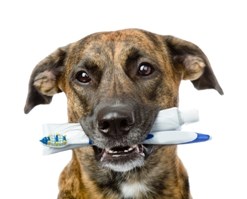How do you keep your German Shorthaired Pointer’s teeth clean and healthy? First, don’t use toothpaste meant for humans, because there are chemicals in it that would be harmful to your dog if he were to swallow them. (As smart as the shorthair is, he has not figured out how to spit out toothpaste.) Instead, use canine toothpaste with delectable doggie flavors, such as chicken or beef.
Most people are very aware of human dental health but don’t think about keeping their dog’s teeth clean and free of decay. Just like people, however, dogs will have dental decay. The American Veterinary Dental Society says that 80 percent of dogs show dental disease by the age of three. German Shorthaired Pointer’s tend to have healthier teeth than some of the more problematic toy breeds, but they are by no means immune.
If you start your puppy with a toothbrush, he is more than likely going to gnaw and chew it, and not much brushing will get done. With a pup, use a finger brush, which is made of rubber, and knobby. Be aware that puppy teeth are very sharp. When sticking your finger into his mouth, you may wonder if you’re actually trying to brush the teeth of a great white shark.
Don’t try to do too much the very first time you brush your puppy’s teeth. Shoot for a quick rub or two and follow this with lots of praise. As your puppy gets used to it, you can add more of a brushing motion, especially at the place where he will build up the most plaque (where teeth and gums meet). Eventually you will be able to use a brush, but that’s up to you.
When you brush, keep an eye out for problems. Look for anything different that could be a cavity or other problem, as well as broken or split teeth. (Be careful what you let your German Shorthaired Pointer chew—ask your veterinarian if you are in doubt about whether something is good or bad for your dog’s teeth.) If you notice something amiss, see your veterinarian. Your veterinarian will also be able to advise you about things such as canine mouthwashes, gels, and foods that help your dog’s dental health.
Just as you visit your dentist for routine cleaning even though you brush and floss every day (because your daily brushing routine will not completely prevent plaque buildup), so, too, will your dog need to visit the veterinarian for an annual cleaning. Veterinary cleanings are not inexpensive because they require that the dog be under light anesthesia during the process.
The cleaner you keep your dog’s teeth, however, the less expensive this visit to the veterinarian’s office will be and the less time your dog will spend under anesthesia. An additional benefit of this annual cleaning is the application of a sealant to your dog’s teeth, which helps retard the growth of plaque and tartar.
Oral Treats, Chews and Gels
Many products claim to have tartar and plaque removing capabilities. To ensure that the products you are buying are effective in retarding plaque and tartar, look for the “accepted” seal of approval by the Veterinary Oral Health
Council (VOHC). The VOHC’s list of products can be accessed at www.vohc.org/ accepted_products.htm. Products include treats, chews, gels, oral sprays, water additives, and foods. (Note: Dental foods are effective only if the dog chews his food.) In addition to brushing a dog’s teeth, you might also consider the following helpful products, approved by the VOHC as being effective.
- Anti-plaque water additive: Products vary, but roughly 1 tablespoon and 1 tea‑ spoon are added to 1 gallon (3.8 L) of water; dog is “served” water as mixed.
- Anti-plaque gel: A thin layer of gel is applied to the gum line nightly after
meals. - Anti-plaque oral spray: The product is sprayed at the gum line nightly after
meals.

